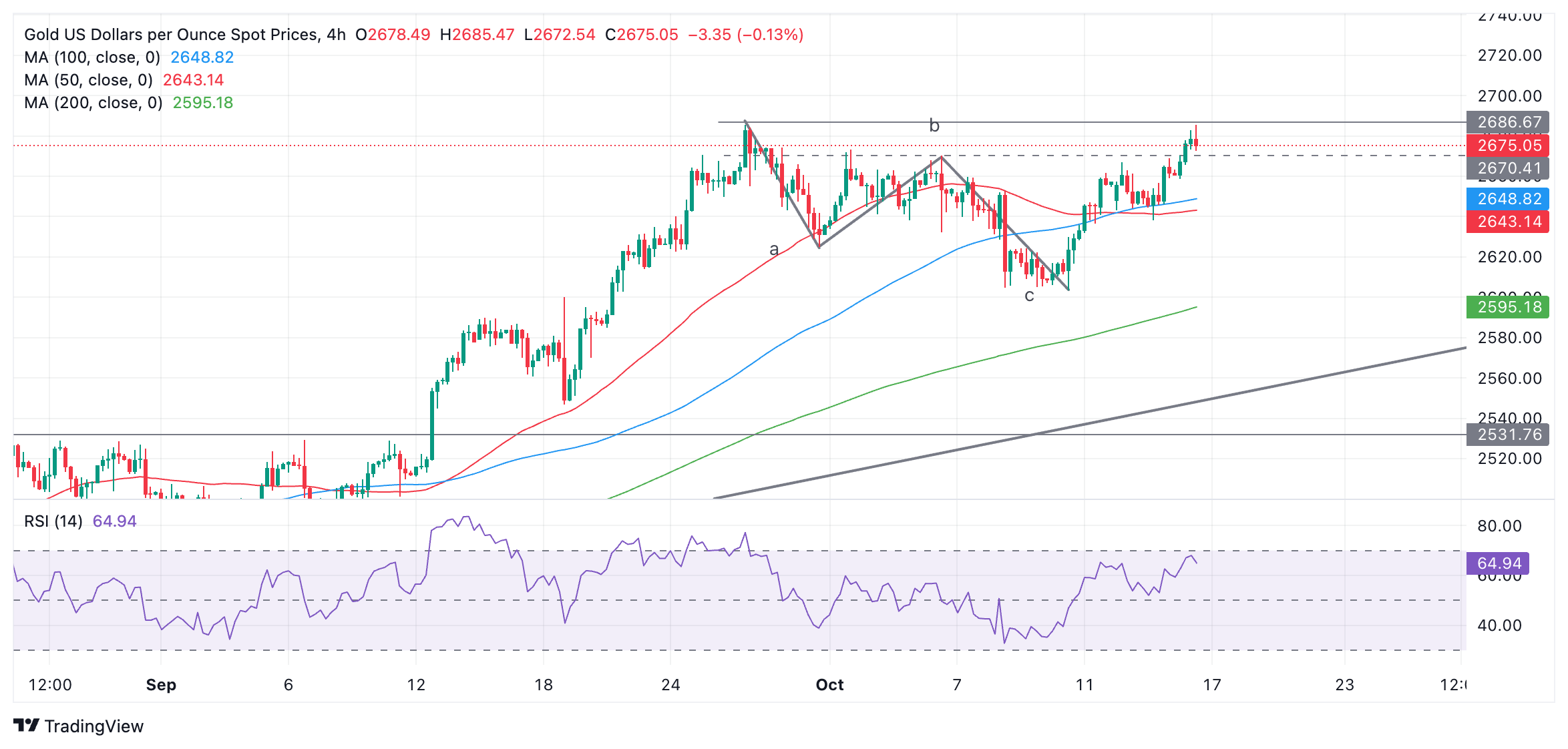- Gold rallies ever closer to its previous all-time high at $2,685.
- A decline in manufacturing activity in the state of New York triggered the latest bout of buying.
- A break above would signal a new all-time high and an extension of the dominant bull trend.
Gold (XAU/USD) extends its recovery to just shy of the $2,685 all-time high on Wednesday after market jitters caused by a dip in US Manufacturing data on Tuesday led to a decline in the US Dollar (USD), a fall in US Treasury yields and a downward revision to the expected path of US interest rates. Lower expected interest rates are bullish for Gold as they reduce the opportunity cost of holding the non-interest paying asset.
Gold rises after US Manufacturing data miss
Gold strengthens after the NY Empire State Manufacturing Index declined into negative territory in October, registering minus 11.4 following an 11.5 rise in September and undershooting expectations of 2.3. This took the index to its lowest level in five months after August’s brief-lived recovery.
That said, the upside for Gold may be limited as Federal Reserve (Fed) officials refrain from adopting a too dovish stance judging from recent commentary. On Tuesday, Bank of San Francisco Fed President Mary Daly said she saw one or two more rate cuts this year, “If forecasts are met.” Her speech scored a neutral 5.8 on the FXStreet FedTracker, which uses a custom AI to gauge the tone of Fed officials’ speeches on a dovish-to-hawkish scale from 0 to 10. This was above her long-running average of 4.5.
Federal Reserve Bank of Atlanta President Raphael Bostic, meanwhile, scored a 6.2 on the FedTracker, which was also above his average of 5.1. Bostic opined the “US economy is doing well,” and that he did not see a recession on the horizon.
Currently, markets are pricing in almost a 94% chance of a 25 basis point cut in the fed funds rate in November and a 6% probability of no-change at all, according to the CME FedWatch tool.
Gold market movers on the calendar
Investors now look ahead to US September’s Retail Sales data on Thursday and a speech from Fed Governor Waller on Friday for further guidance.
Elsewhere, elevated tensions in the Middle East could help sustain upward momentum for Gold, particularly amid heightened expectations Israel will launch an imminent retaliatory attack on Iran.
Technical Analysis: Gold closes in all-time high
Gold extends another leg higher as it recovers from the October 10 low following the conclusion of a three-wave (abc) counter-trend reaction.
XAU/USD 4-hour Chart

Gold has broken above key resistance at around $2,670, and it is closing in on the $2,685 all-time high. A break above that level would indicate a continuation to the next target at $2,700 – a round number and psychological level.
Gold is in an uptrend on a short, medium, and long-term basis, and given the theory that “the trend is your friend,” the odds continue to favor more upside.
It would require a break below $2,600 (low of wave c on the chart) to flip the uptrend and turn the short and medium-term outlooks bearish.
Gold FAQs
Gold has played a key role in human’s history as it has been widely used as a store of value and medium of exchange. Currently, apart from its shine and usage for jewelry, the precious metal is widely seen as a safe-haven asset, meaning that it is considered a good investment during turbulent times. Gold is also widely seen as a hedge against inflation and against depreciating currencies as it doesn’t rely on any specific issuer or government.
Central banks are the biggest Gold holders. In their aim to support their currencies in turbulent times, central banks tend to diversify their reserves and buy Gold to improve the perceived strength of the economy and the currency. High Gold reserves can be a source of trust for a country’s solvency. Central banks added 1,136 tonnes of Gold worth around $70 billion to their reserves in 2022, according to data from the World Gold Council. This is the highest yearly purchase since records began. Central banks from emerging economies such as China, India and Turkey are quickly increasing their Gold reserves.
Gold has an inverse correlation with the US Dollar and US Treasuries, which are both major reserve and safe-haven assets. When the Dollar depreciates, Gold tends to rise, enabling investors and central banks to diversify their assets in turbulent times. Gold is also inversely correlated with risk assets. A rally in the stock market tends to weaken Gold price, while sell-offs in riskier markets tend to favor the precious metal.
The price can move due to a wide range of factors. Geopolitical instability or fears of a deep recession can quickly make Gold price escalate due to its safe-haven status. As a yield-less asset, Gold tends to rise with lower interest rates, while higher cost of money usually weighs down on the yellow metal. Still, most moves depend on how the US Dollar (USD) behaves as the asset is priced in dollars (XAU/USD). A strong Dollar tends to keep the price of Gold controlled, whereas a weaker Dollar is likely to push Gold prices up.
Information on these pages contains forward-looking statements that involve risks and uncertainties. Markets and instruments profiled on this page are for informational purposes only and should not in any way come across as a recommendation to buy or sell in these assets. You should do your own thorough research before making any investment decisions. FXStreet does not in any way guarantee that this information is free from mistakes, errors, or material misstatements. It also does not guarantee that this information is of a timely nature. Investing in Open Markets involves a great deal of risk, including the loss of all or a portion of your investment, as well as emotional distress. All risks, losses and costs associated with investing, including total loss of principal, are your responsibility. The views and opinions expressed in this article are those of the authors and do not necessarily reflect the official policy or position of FXStreet nor its advertisers. The author will not be held responsible for information that is found at the end of links posted on this page.
If not otherwise explicitly mentioned in the body of the article, at the time of writing, the author has no position in any stock mentioned in this article and no business relationship with any company mentioned. The author has not received compensation for writing this article, other than from FXStreet.
FXStreet and the author do not provide personalized recommendations. The author makes no representations as to the accuracy, completeness, or suitability of this information. FXStreet and the author will not be liable for any errors, omissions or any losses, injuries or damages arising from this information and its display or use. Errors and omissions excepted.
The author and FXStreet are not registered investment advisors and nothing in this article is intended to be investment advice.
Recommended content
Editors’ Picks

EUR/USD drops to two-year lows below 1.0400 after weak PMI data
EUR/USD stays under bearish pressure and trades at its weakest level in nearly two years below 1.0400. The data from Germany and the Eurozone showed that the business activity in the private sector contracted in early November, weighing on the Euro.

GBP/USD falls to six-month lows below 1.2550, eyes on US PMI
GBP/USD extends its losses for the third successive session and trades at a fresh fix-month low below 1.2550 on Friday. Disappointing PMI data from the UK weigh on Pound Sterling as market focus shift to US PMI data releases.

Gold price refreshes two-week high, looks to build on momentum beyond $2,700 mark
Gold price hits a fresh two-week top during the first half of the European session on Friday, with bulls now looking to build on the momentum further beyond the $2,700 mark. This marks the fifth successive day of a positive move and is fueled by the global flight to safety amid persistent geopolitical tensions stemming from the intensifying Russia-Ukraine war.

S&P Global PMIs set to signal US economy continued to expand in November
The S&P Global preliminary PMIs for November are likely to show little variation from the October final readings. Markets are undecided on whether the Federal Reserve will lower the policy rate again in December.

A new horizon: The economic outlook in a new leadership and policy era
The economic aftershocks of the COVID pandemic, which have dominated the economic landscape over the past few years, are steadily dissipating. These pandemic-induced economic effects are set to be largely supplanted by economic policy changes that are on the horizon in the United States.

Best Forex Brokers with Low Spreads
VERIFIED Low spreads are crucial for reducing trading costs. Explore top Forex brokers offering competitive spreads and high leverage. Compare options for EUR/USD, GBP/USD, USD/JPY, and Gold.